Top 12 Reverb Pedals From $30 to +$200
The Reverb Guide
The Reverb Effect
What is the Reverb effect?
Reverberation is the persistence of sound waves after a sound is produced.
A reverb is created when a sound or signal is reflected causing a large number of reflections to build up and then decay as the sound is absorbed by the surfaces of objects in the space.
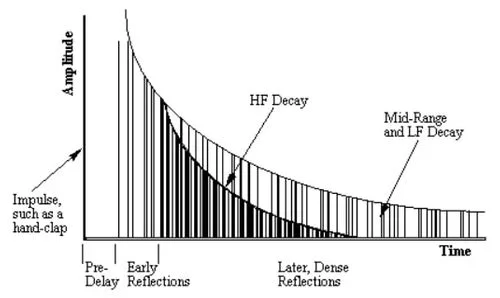
This is most noticeable when the sound source stops but the reflections continue, decreasing in amplitude until they reach zero amplitude (volume).
These are the takeaways you should take from this section. A reverb pedal creates a set of reflections of the original sound with the following characteristics:
- Pre-Delay
- Decay: how long it takes to reach zero amplitude
- Different decay times for the low/mid/high frequencies
Analog dry path VS digital dry path
Analog dry path means that the incoming signal from the guitar goes straight through the stompbox and out the pedal’s output, so it is not converted to digital. Only the part of the signal that is processed (wet) by the pedal is converted to digital.
This means that the dry (unprocessed) signal from the guitar is sent straight to your amp as if there were no pedal in the chain at all.
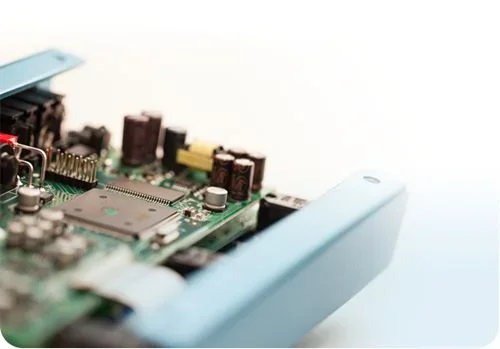
The problem with effects pedals that implements analog dry paths suffer from signal conversion latency issues. This can cause a phase distortion between the wet and dry signals and produce some unexpected behaviors.
On the other hand, a digital dry path implementation manages the dry signal inside the DSP (digital signal processor), having ultimate control over the whole signal processing. This opens up new opportunities for modulation effects pedals, such as the following:
- Global tone controls
- Flexible stereo routing
- Subtractive wet mix
- Low cut
- Parametric EQ
- Clean boost
- Costs reduction
Types of reverb effects
Shimmer
One of the most popular reverb effects these days, also known as pitch-shifter. The shimmer adds octave intervals producing mind-blowing space sounds. A great effect of ambiance guitar experimentation.
Spring
THE classic/vintage reverb type, used in all kind of music styles by all kind of guitar players.
Plate Reverb
Based on the sound that produced old metal-plate machines to create mechanical reverberations.
The plate reverb is known for being able to create long decay times while creating a few reflections (focused reverb).
Hall
As you can imagine, a hall reverb tries to emulate the natural reverberation that we can find in concert halls.
It produces big sounds with long decay times and plenty reflections.
Room
Contrary to the Hall effect, the Room reverb simulates the natural reverberation of small places… like a room for instance.
Produces short decay times and a short number of reflections.
Comparing The Reverb To Other Modulation Effects
Reverb vs Echo vs Delay
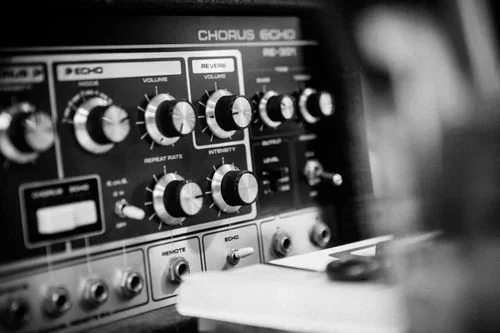
These effects are all similar in application, as they are all typically used at the end of the signal chain or in an effects loop to create an ambient effect.
In order to choose what fits your needs best, you must know the difference between the different effects.
Starting with the Delay effect, it is known for producing repeats of the original signal. So this effect doesn’t really modify the original wave characteristics.
Then we have the Echo, which is pretty similar to the reverb. An echo effect produces reflections that reach your ear in more than 0.1 seconds after the original sound wave.
On the other hand, a Reverberation produces reflections that reach your ear in less than 0.1 seconds after the original sound wave. Since the original sound wave is still held in memory, there is no time delay between the perception of the reflected sound wave and the original sound wave. The two sound waves tend to combine as one very prolonged sound wave.
How to combine the three effects
It’s a common practice to use reverb and delay pedals together. How to use them is up to you!
You can put the reverb after the delay, which will boost the reverberation “pre-delay” component.
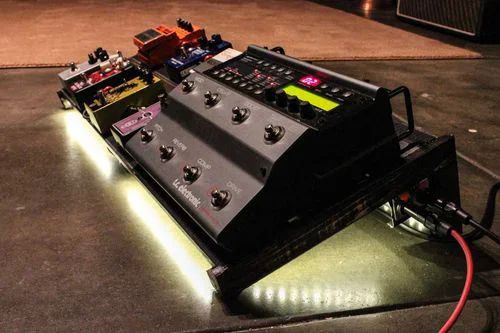
You can also use them in reverse order putting the delay after the reverb, which will dramatically increase the reverberation decay thanks to the delay repetitions.
The echo is just a time-delayed reverberation, so play around with it and try it in different positions of your signal chain to create mind blowing effects.
Where Can I Find The Best Reverb Pedals?
Now that you know a little more about reverb pedals, you are ready to take the next step and start experimenting.
The question is: what pedals should I start with?
Let me tell you there are TONS of reverb pedals, ranging all kind of budgets, needs, features and designs. Finding the best for you can be a difficult task.
In the following sections of this guide we will explore the best reverb pedals covering a wide range of prices and features.
Top 6 Reverb Pedals Under $150
Caline CP-26 Snake Bite Reverb
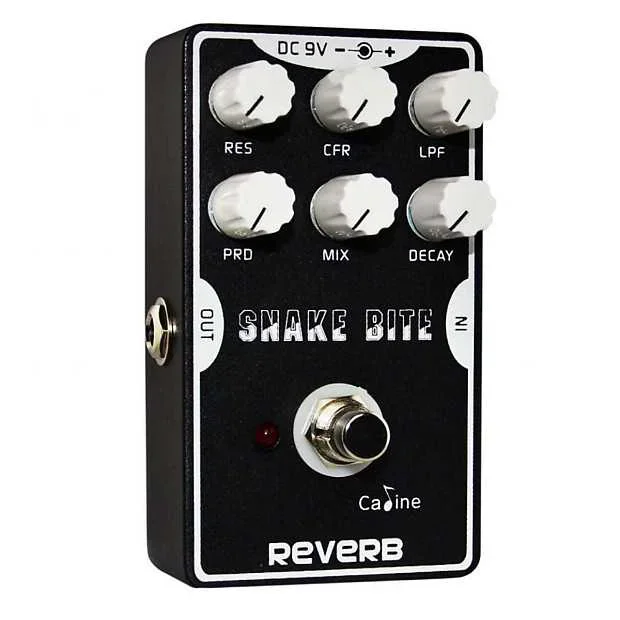
Here we have the CP-26 Snake Bite, a digital reverb effects pedal from Caline, an Asiatic brand that started in the pedals business in 2010.
And as a good asiatic product, it’s functional and visually simple. But don’t get me wrong, this is an awesome product for the price.
The Snake Bite does not include any “reverb mode” knob with preset reverb effects. Instead, it features 6 knobs to fully control all the effect details:
- RES (resonance): simulate resonant response in different environment of acoustics
- CFR (center frequency): it modifies the effect from a dark sounding reverb all the way up to bright and sparkly sounding reverb
- LPF (low pass filter): a fairly uncommon control to have on a reverb, but quite useful and it adds a lot of flavor to the effect, it also is a kind of tone control based on reducing highs, this control lets you add warmth to the reverb effect and it goes all the way up to cold and sterile reverb sounds
- PRD (pre-delay): set the time between your signal and the reverb effect, meant to be used in conjunction with the reverb
- MIX: adjust the amount of the reverb effect with your signal
- DECAY: adjust the length reverb before it fades out
You won’t find anything better for this price.
Donner Verb Square
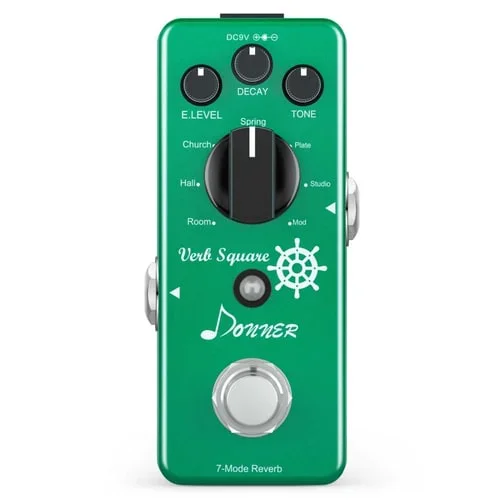
The Donner Verb Square is the go-to reverb pedal for tight budgets. This awesome super-compact is the perfect choice if you want to get started with reverb effects and play around with different modes.
- 7 modes included: room, hall, church, spring, plate, studio and mod
- True-bypass, digital circuitry
- Super compact design (95 x 45 x 48 mm)
- Aluminum housing
Highly recommended!
Deadbeat The Void
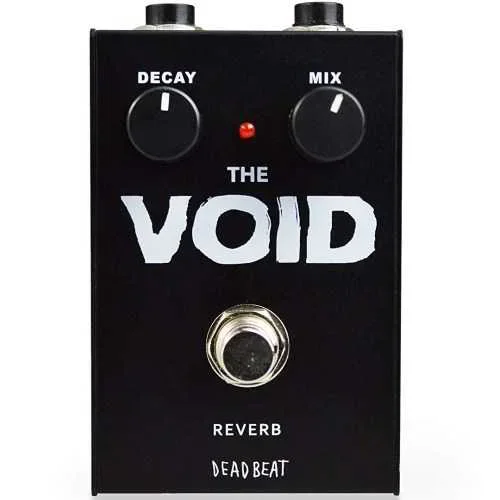
The Deadbeat’s “The Void” features a single reverb mode with two controls: Decay and Mix.
Even so, its greatness lies in its simplicity, with a solid and well-defined reverb effect, a compact enclosing and some “freebies”: a 9V DC power supply and two pad cables.
This is a pretty simple pedal only recommended for those who want a standard reverb sound. You can’t test different reverb modes as in other common reverb effects pedals, so if you want to experiment with different modes, go for another model.
Also, if you already have a power supply, it would be wiser to look for another pedal, such as the Donner Verb Square.
TC Electronic Hall of Fame 2
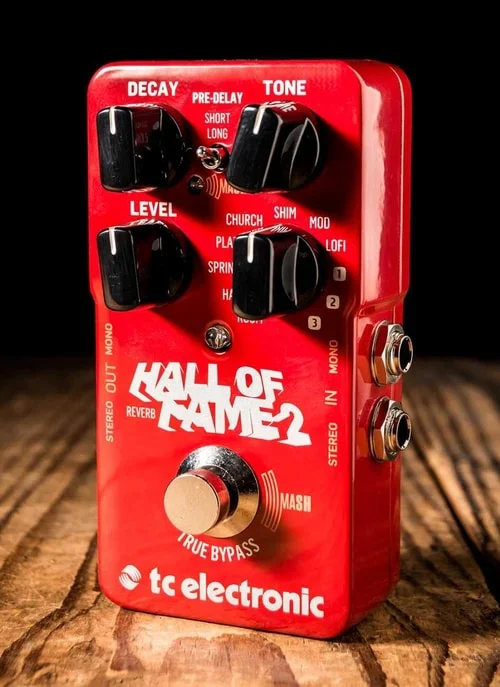
The TC Electronic Hall of Fame 2 is one of the best reverb effects pedal you can find in the market right now.
It was released in mid-2017, and it includes some features that make it pretty unique:
- Customizable reverb presets via the TonePrint app (for desktop and mobiles)
- You can even download presets from guitar stars like Satchel or Guthrie Govan!
But that’s not all. This 100% analog dry path pedal features the most common reverb modes as well as an improved version of their unique Shimmer algorithm.
Boss RV-6 Digital Reverb
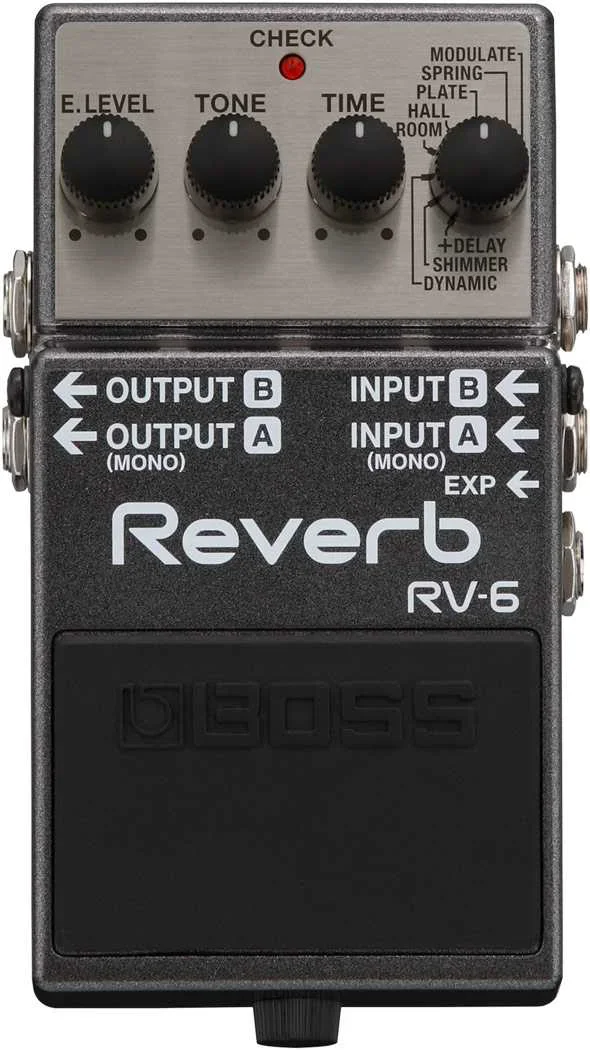
The Boss RV-x series has been around for a while now. The latest iteration, the RV-6, comes with some improvements that make this pedal quite awesome. Here are some of the most important features:
- Reverb modes: Room, Hall, Plate, Sprint, Modulate
- Extra modes: Shimmer, Dynamic, and Delay
- Controls: effect level, tone, time and mode
- Digital pedal with analog dry path
There is a lot of people that have discovered a gem in this pedal: the Shimmer mode. This distinctive reverb type generates a sparkling high-frequency range. It produces fantasy-like reverberation wrapped in spacious overtones. Pretty mind-blowing.
Digitech Polara
The Digitech Polara is the preferred for those who want both a great reverb pedal and experimenting with unique reverb effects.

Despite its compact size, the Polara is solidly built and surprisingly heavy due to its metal housing.
This digital reverb effects pedal comes with 7 Lexicon reverb modes: Room, Plate, Reverse, Modulated, Halo, Reverb, Spring.
I encourage you to check the Halo mode, one of the biggest claims of this pedal.
Other features:
- 100% Dry analog signal path
- Independent Level, Liveliness, Decay and Type controls
- Stereo inputs and outputs
- Reverb Tails On/Off toggle switch
- StompLock (knobs protection pad)
You can find the official pedal documentation here.
Top 6 Reverb Pedals Over $150
Caroline Météore Lo-Fi Reverb
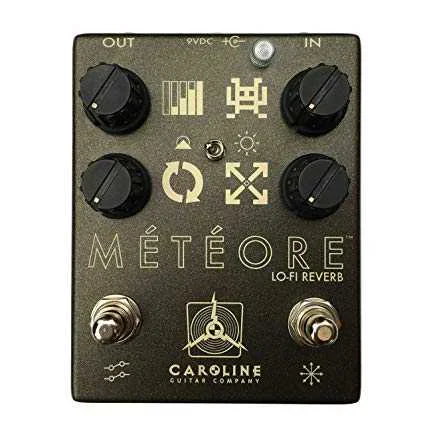
The Caroline Guitar Company Meteore Lo-Fi Reverb (couldn’t be longer) pedal puts the sound of vintage spring reverbs onto your pedalboard with some very interesting twists.
This reverb digitally emulates the spring tanks of vintage amps with full control over the level, attack, regeneration, and size, thanks to the four separate knobs:
- Level (mix): sets the overall volume of the effect relative to your original signal
- Attack: sets the amount of gain in the preamp, allowing you to boost or overdrive the reverb
- Regeneration: extends the decay and adds overtones
- Size: sets the initial reverberation
If you set the Size and Regeneration knobs to the highest levels, you will create a self-oscillating mind-blowing effect.
It also adds two extra controls to further customize the reverb effect:
- Dark/Bright toggle: to set the overall pedal voice (emphasizes either lower or higher frequencies)
- Havoc switch: when switched on, the pedal creates extended, seemingly infinite holds, gradual runaways or instant collapse, depending on the Size setting. Releasing it will return the effect to the level of the Regeneration control
The Meteore Lo-Fi Reverb is an interesting choice if you want to create your OWN unique reverb sound rather than using a set of predefined reverb sounds.
MXR M300 Reverb
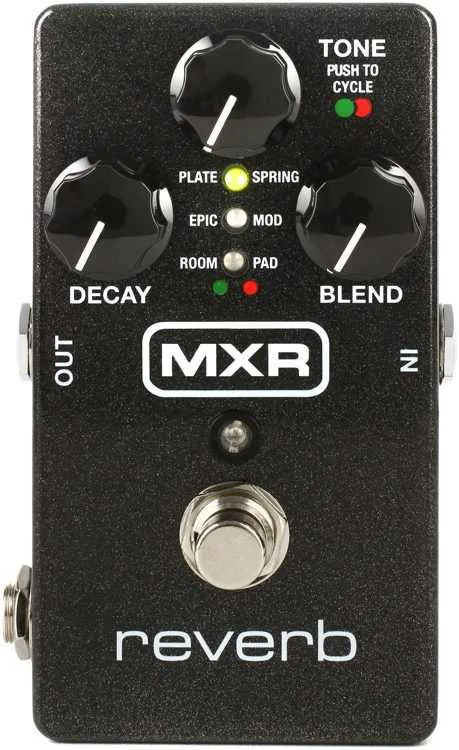
We had to wait a long time to see a reverb pedal from MXR. Released back in 2016, the MXR M300 has been scaling positions right to the top of the best selling reverb pedals of the moment.
Although packed in a compact box, this pedal lacks nothing: simple to set up but full of features for the most advanced users.
Bonus point: includes an ECB003 9V power supply.
Six Reverb Types In One Pedal
Inside this compact pedal, you have access to six types of ambient sounds: Room, Epic, Plate, Spring, Mod and Pad.
They all are switchable with a push of the Tone control.
Each of these reverb types are controlled by a high-quality digital chipset while the 100% analog dry signal keeps separated from the digital tone path. This keeps your signal clean and clear.
Easy To Use
No one wants a pedal that takes ages to set up. Simplicity is key especially with things like reverb, that is why the MXR just has three simple controls.
- Mix: sets the dry/wet mix of the effect
- Tone: sets the bright/dark voice of the effect. It’s also used to select the reverb type
- Decay: sets how long you want the reverb to last
Advanced Features
- The expression pedal input allows you to toggle between two different setting configurations for further increase the possibilities this pedal can bring
- This pedal is true bypass by default. This has the side effect of cutting off your reverb tails when switching the pedal off. The MXR 300 has a selectable Trails Bypass mode, which uses a buffered bypass, allowing your reverbs to ring out even after you turn the pedal off
- Also, it can be run in either Mono (default) or Stereo modes, selectable via internal switch, which determines tip/ring input connection
You can find more information about how to use these advanced features in the official manual here.
Electro-Harmonix Holy Grail Max
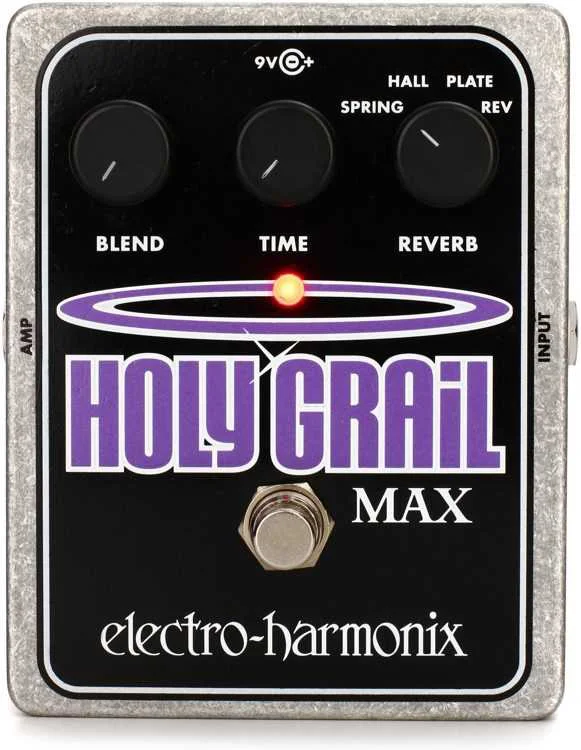
Here we have the EHX Holy Grail Max Reverb, one of the latest revisions of one of the most used reverb pedals in the past two decades.
Check this awesome post to see how this model fits in the EHX Holy Grail family.
Bonus point: a 9.6V power supply is included.
Four Studio Quality Reverb Types
This pedal includes four reverb sounds: spring, hall, plate and reverse.
To avoid repeating my self to much explaining the main features of common reverb types, I will just elaborate on the reverse type, which is a reverb sound that is not usually included in other pedals.
This odd reverb type will create reverse reverb after a note is played. Check out the pedal video at 3:28 to see it in action… pretty awesome and mind-blowing! 🙂
The length of time between playing a note and hearing the reverse reverb completely fade-in is set by the time knob.
The further you turn TIME clockwise, the longer the note will take to fade-in. For short TIME settings, the REVERSE mode can sound like a slap-back echo.
Simple Design, Unlimited Options
The EHX Holy Gral Max actually have two knobs to customize the reverb effect as the far right knob is used to select the reverb type. This is how the knobs work:
- Reverb: chooses the reverb mode
- Blend: sets the wet/dry mix
- Time:
- default: adjusts the decay time, or reverb length/size, for the spring, hall and plate reverbs
- reverse mode: sets the length of time between striking a note and the reverb fade-in
- plate mode: if it’s set to its maximum position, the reverb decay is over 30 seconds creating a lush reverb wash with each new note
EarthQuaker Afterneath V2

With an upgraded silent switching system, version 2 of the EarthQuaker Devices Afterneath reverb pedal is better than ever.
- Handmade in the USA
- 100% dry signal path. Reverb digital processing doesn’t affect the original dry signal
- It uses silent relay-based soft touch switching so audio will not pass without power
- Ready to use with guitars, basses, keyboards and synths!
No Presets + 6 Knobs = Unique Sounds
If you want to go far beyond traditional reverb effects, then you definitely should check out the Afterneath v2.
This digital reverb is made up of a swarm of short delays, which separates the delay lines creating a stuttering, pingy effect, perfect for ambiance sounds.
Minimal settings allow you to create room and hall reverb effects, while more extreme settings border on self-oscillation, without actually drowning out your dry signal.
- Length: sets the decay length of the reverb
- Diffuse: adjusts the spread of the reverb. Sharper with more attack counter clockwise, more ambient and washy as you turn it clockwise.
- Dampen (tone): sets the pedal’s brightness/darkness
- Drag: this is the coolest control on the Afterneath. More delay as you turn it counterclockwise, more reverb as you turn it clockwise.
- Reflect: controls the regeneration of the reverb, turn clockwise for more wash and echos, counterclockwise for less. This will self-oscillate if turned up high.
- Mix: blends the wet signal into the dry
What’s New In The V2?
EarthQuaker redesigned a number of circuit boards to make way for its relay-based soft touch switching, and the benefits are many.
How is this switch different? When engaging the pedal, there is no hard click and no audible “pop” either.
So, switching it on/off is now more comfortable than ever and soundless!
Red Panda Context
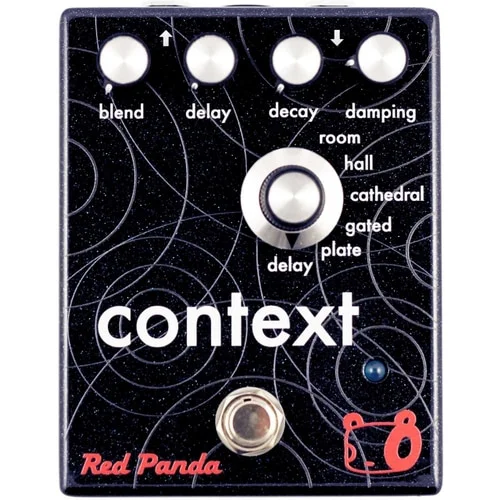
The Red Panda Context combines the best 80s digital reverb algorithms with a clean signal path. All of the algorithms are adjustable so that you can get the right combination of pre-delay, reverb time, and tone.
Presets + 4 Knobs = Perfect Customization Balance
If you are looking for a high-quality reverb capable of crafting textures and soundscapes, while also covering the general use of reverb, this can be the best reverb for your needs.
Controls:
- blend adjusts wet/dry blend, up to 100% wet.
- delay sets pre-delay, to simulate natural spaces or increase presence.
- decay adjusts reverb time, from very tight to massive.
- damping adjusts high-frequency response, to keep the reverb from taking over other instruments’ space or create dark ambiance.
Preset reverb modes:
- Room: fast buildup
- Hall: slow buildup with moderate diffusion
- Cathedral: bright reverb with extended response
- Gated: adjustable gate time with nonlinear decay
- Plate: bright and dense reverb with adjustable reverb time, low- and high-frequency response
- Delay: adjustable delay time, repeats, and reverb amount
Keeping a Clean Signal
Context adds depth to your sound without unwanted coloration.
The dry signal passes through Burr-Brown op-amps and WIMA poly film caps in a 100% analog signal path.
It also has an internal switch to select between true bypass and trails:
- True bypass completely removes the Context from your signal path when not needed
- Trails allows the reverb to decay naturally, and also works as a high-quality buffer. With trails on, the blend control is active in bypass to maintain a consistent volume
Keeley Loomer
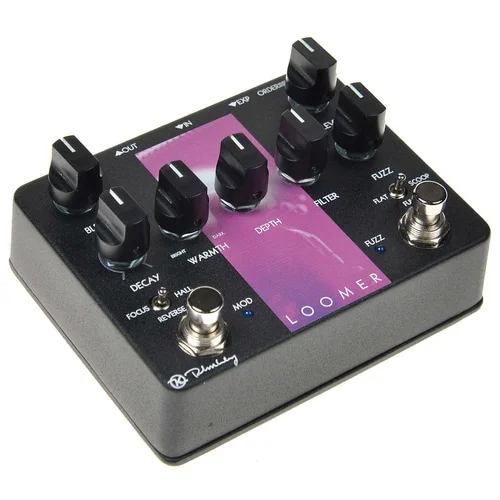
Released in late 2016, the Keeley Loomer combines a well-nurtured set of reverbs with a Muff-style fuzz in a full-size enclosure with 7 controls to get the most out of this ultra-versatile workstation.
Exploring The Presets
Reverb:
- Hall: super long ambient wash with the ability to add an ascending shimmer octave up in the feedback loop
- Reverse: based on the Yamaha SPX90, you can set different delay times with the Decay control which gives you rhythmic reverse
- Soft Focus: because all of the reverbs can go all-wet by means of the Blend Control, this is a great approximation of the Yamaha FX500 patch. Soft Focus Reverb features a dense reverb with two delays in parallel (one set for 250ms, the other set for 380ms.)
Fuzz modes just vary the equalization of the effect as follows:
- Flat: flat equalization curve
- Scoop: this is the standard fuzz eq curve, where bass and trebles are boosted
- Full: in this darker mode, the bass and mids are boosted
7 Knobs + Some Other Controls. Isn’t That Too Many?
Considering that this pedal combines two effects pedals, it’s actually what we could expect.
The Loomer has two separate footswitches, to activate/deactivate each effect.
For each effect, there is a 3-way switch to control the main character of the effect:
- For the reverb effect, you can select between Focus, Reverse and Hall
- For the fuzz effect, you can select between Flat, Scoop and Full
As for the knobs, let’s see what is the function of each one:
- Level: controls the output volume of the Fuzz circuit
- Fuzz: controls the gain
- Filter: controls the tone of the Fuzz
- Blend: controls the amount of wet signal is blended from the Reverb circuit
- Decay: in Focus mode, this is both the Reverb decay time and the feedback for the dual delays. Reverse repurposes it as an 8-way switch for decay times ranging from 150-500ms, and in Hall mode, it serves as the decay time
- Warmth: tone control for the reverb
- Depth: multi-purpose knob, controlling the amount of shimmer in the Hall reverb or the depth of modulation in the Reverse and Focus
Where To Put It In The Signal Chain
Considering conventional wisdom tells us Overdrive and Fuzz should be near the start of the chain, while Reverb should be towards the end, leaving room for modulation effects throughout the space in between… where should you put this all-in-one Fuzz+Reverb pedal?
Originally, Keeley included a TRS input to allow for signal-chain experimentation, but due to popular demand, they opted to replace this option with a button that swaps the fuzz and ’verb on the fly.
The problem I see with this new button is that you can’t add any other effect between the Loomer fuzz and reverb. You can either put the fuzz after the reverb or the other way around.
Using Expression Pedals
Lastly, the Kelley Loomer includes an expression pedal input that allows the guitarist an additional flexibility degree that many other reverbs with similar sound quality of similar price range just don’t offer. Not to mention the inclusion of a great quality Fuzz.
Wrapping Up!
You did it! We covered a lot of material in this guide I really hope going through it has helped you to learn something new about reverb pedals and that it also helped you to discover new pedals you might didn’t know about.
To close this up with an awesome video from Roland, where you can learn all the basics of reverb pedals. Johnny DeMarco guides you through every knob in the Boss RV-6, which are pretty common in other models, explaining the effect that they have on the tone, as well as the different reverb modes that we talked about at the beggining of this guide. Enjoy!